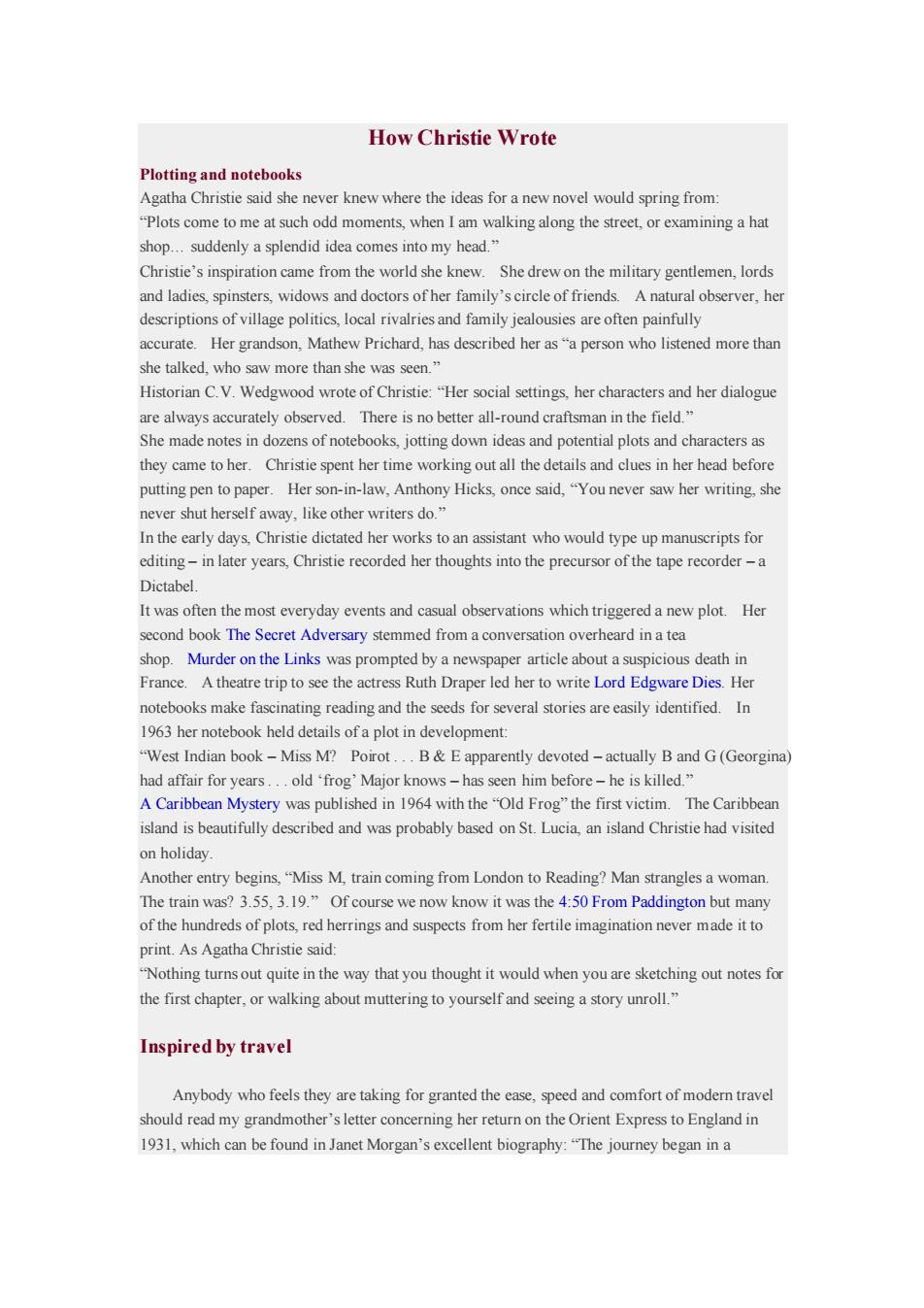正在加载图片...

How Christie Wrote Plotting and notebooks Agatha Christie said she never knew where the ideas for a new novel would spring from "Plots come to me at such odd moments,when I am walking along the street,or examining a hat shop...suddenly a splendid idea comes into my head." Christie's inspiration came from the world she knew.She drew on the military gentlemen,lords and ladies,spinsters,widows and doctors of her family's circle of friends.A natural observer,her descriptions of village politics,local rivalries and family jealousies are often painfully accurate.Her grandson,Mathew Prichard,has described her as"a person who listened more than she talked,who saw more than she was seen." Historian C.V.Wedgwood wrote of Christie:"Her social settings,her characters and her dialogue are always accurately observed.There is no better all-round craftsman in the field." She made notes in dozens of notebooks,jotting down ideas and potential plots and characters as they came to her.Christie spent her time working out all the details and clues in her head before putting pen to paper.Her son-in-law,Anthony Hicks,once said,"You never saw her writing,she never shut herself away,like other writers do." In the early days,Christie dictated her works to an assistant who would type up manuscripts for editing-in later years,Christie recorded her thoughts into the precursor of the tape recorder-a Dictabel It was often the most everyday events and casual observations which triggered a new plot.Her second book The Secret Adversary stemmed from a conversation overheard in a tea shop.Murder on the Links was prompted by a newspaper article about a suspicious death in France.A theatre trip to see the actress Ruth Draper led her to write Lord Edgware Dies.Her notebooks make fascinating reading and the seeds for several stories are easily identified.In 1963 her notebook held details of a plot in development: "West Indian book-Miss M?Poirot...B&E apparently devoted-actually B and G(Georgina) had affair for years...old 'frog'Major knows-has seen him before-he is killed." A Caribbean Mystery was published in 1964 with the"Old Frog"the first victim.The Caribbean island is beautifully described and was probably based on St.Lucia,an island Christie had visited on holiday. Another entry begins,"Miss M,train coming from London to Reading?Man strangles a woman. The train was?3.55,3.19."Of course we now know it was the 4:50 From Paddington but many of the hundreds of plots,red herrings and suspects from her fertile imagination never made it to print.As Agatha Christie said: "Nothing turns out quite in the way that you thought it would when you are sketching out notes for the first chapter,or walking about muttering to yourself and seeing a story unroll." Inspired by travel Anybody who feels they are taking for granted the ease,speed and comfort of modern travel should read my grandmother's letter concerning her return on the Orient Express to England in 1931,which can be found in Janet Morgan's excellent biography:"The journey began in aHow Christie Wrote Plotting and notebooks Agatha Christie said she never knew where the ideas for a new novel would spring from: “Plots come to me at such odd moments, when I am walking along the street, or examining a hat shop… suddenly a splendid idea comes into my head.” Christie’s inspiration came from the world she knew. She drew on the military gentlemen, lords and ladies, spinsters, widows and doctors of her family’s circle of friends. A natural observer, her descriptions of village politics, local rivalries and family jealousies are often painfully accurate. Her grandson, Mathew Prichard, has described her as “a person who listened more than she talked, who saw more than she was seen.” Historian C.V. Wedgwood wrote of Christie: “Her social settings, her characters and her dialogue are always accurately observed. There is no better all-round craftsman in the field.” She made notes in dozens of notebooks, jotting down ideas and potential plots and characters as they came to her. Christie spent her time working out all the details and clues in her head before putting pen to paper. Her son-in-law, Anthony Hicks, once said, “You never saw her writing, she never shut herself away, like other writers do.” In the early days, Christie dictated her works to an assistant who would type up manuscripts for editing – in later years, Christie recorded her thoughts into the precursor of the tape recorder – a Dictabel. It was often the most everyday events and casual observations which triggered a new plot. Her second book The Secret Adversary stemmed from a conversation overheard in a tea shop. Murder on the Links was prompted by a newspaper article about a suspicious death in France. A theatre trip to see the actress Ruth Draper led her to write Lord Edgware Dies. Her notebooks make fascinating reading and the seeds for several stories are easily identified. In 1963 her notebook held details of a plot in development: “West Indian book – Miss M? Poirot . . . B & E apparently devoted – actually B and G (Georgina) had affair for years . . . old ‘frog’ Major knows – has seen him before – he is killed.” A Caribbean Mystery was published in 1964 with the “Old Frog” the first victim. The Caribbean island is beautifully described and was probably based on St. Lucia, an island Christie had visited on holiday. Another entry begins, “Miss M, train coming from London to Reading? Man strangles a woman. The train was? 3.55, 3.19.” Of course we now know it was the 4:50 From Paddington but many of the hundreds of plots, red herrings and suspects from her fertile imagination never made it to print. As Agatha Christie said: “Nothing turns out quite in the way that you thought it would when you are sketching out notes for the first chapter, or walking about muttering to yourself and seeing a story unroll.” Inspired by travel Anybody who feels they are taking for granted the ease, speed and comfort of modern travel should read my grandmother’s letter concerning her return on the Orient Express to England in 1931, which can be found in Janet Morgan’s excellent biography: “The journey began in a